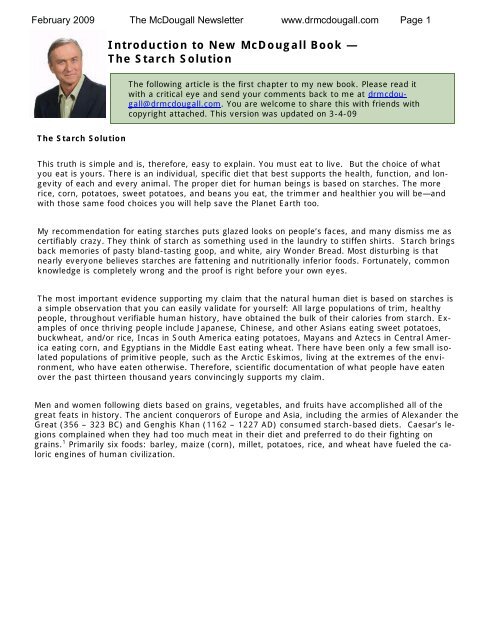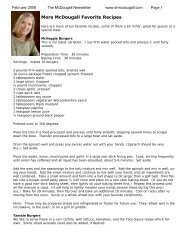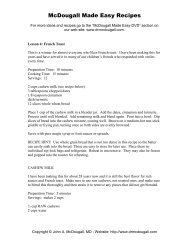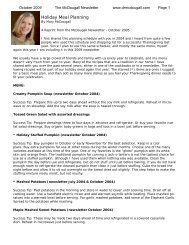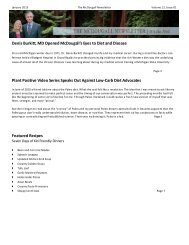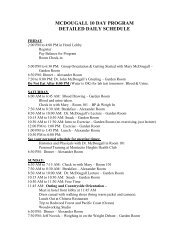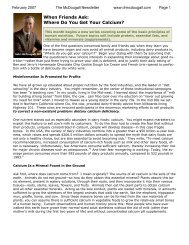Printer Friendly pdf - Dr. McDougall
Printer Friendly pdf - Dr. McDougall
Printer Friendly pdf - Dr. McDougall
Create successful ePaper yourself
Turn your PDF publications into a flip-book with our unique Google optimized e-Paper software.
February 2009 The <strong>McDougall</strong> Newsletter www.drmcdougall.com Page 1Introduction to New <strong>McDougall</strong> Book —The Starch SolutionThe following article is the first chapter to my new book. Please read itwith a critical eye and send your comments back to me at drmcdougall@drmcdougall.com.You are welcome to share this with friends withcopyright attached. This version was updated on 3-4-09The Starch SolutionThis truth is simple and is, therefore, easy to explain. You must eat to live. But the choice of whatyou eat is yours. There is an individual, specific diet that best supports the health, function, and longevityof each and every animal. The proper diet for human beings is based on starches. The morerice, corn, potatoes, sweet potatoes, and beans you eat, the trimmer and healthier you will be—andwith those same food choices you will help save the Planet Earth too.My recommendation for eating starches puts glazed looks on people’s faces, and many dismiss me ascertifiably crazy. They think of starch as something used in the laundry to stiffen shirts. Starch bringsback memories of pasty bland-tasting goop, and white, airy Wonder Bread. Most disturbing is thatnearly everyone believes starches are fattening and nutritionally inferior foods. Fortunately, commonknowledge is completely wrong and the proof is right before your own eyes.The most important evidence supporting my claim that the natural human diet is based on starches isa simple observation that you can easily validate for yourself: All large populations of trim, healthypeople, throughout verifiable human history, have obtained the bulk of their calories from starch. Examplesof once thriving people include Japanese, Chinese, and other Asians eating sweet potatoes,buckwheat, and/or rice, Incas in South America eating potatoes, Mayans and Aztecs in Central Americaeating corn, and Egyptians in the Middle East eating wheat. There have been only a few small isolatedpopulations of primitive people, such as the Arctic Eskimos, living at the extremes of the environment,who have eaten otherwise. Therefore, scientific documentation of what people have eatenover the past thirteen thousand years convincingly supports my claim.Men and women following diets based on grains, vegetables, and fruits have accomplished all of thegreat feats in history. The ancient conquerors of Europe and Asia, including the armies of Alexander theGreat (356 – 323 BC) and Genghis Khan (1162 – 1227 AD) consumed starch-based diets. Caesar’s legionscomplained when they had too much meat in their diet and preferred to do their fighting ongrains. 1 Primarily six foods: barley, maize (corn), millet, potatoes, rice, and wheat have fueled the caloricengines of human civilization.
February 2009 The <strong>McDougall</strong> Newsletter www.drmcdougall.com Page 2Starches Consumed Throughout HistoryBarley – Middle East for 11,000 yearsCorn (maize) – North, Central, and South America for 7,000 yearsLegumes – Americas, Asia, and Europe for 6,000 yearsMillet – Africa for 6,000 yearsOats – Middle East for 11,000 yearsPotatoes – South America (Andes) for 13,000 yearsSorghum – East Africa for 6,000 yearsSweet Potatoes – South America and Caribbean for 5,000 yearsRice – Asia for more than 10,000 yearsRye – Asia for 5000 yearsWheat – Near East for 10,000 yearsOur DNA Nails ItBased on our anatomy and physiology experts have long concluded that primates, including humans,are designed to eat a diet consisting mostly of plant foods. The natural diet of chimpanzees, our closestrelative, is nearly pure vegetarian in composition; made up largely of fruits; and in the dry seasonswhen fruit is scarce, they eat tree seeds, flowers, soft pith, and bark; with termites and small mammalsmaking an insignificant contribution to their nutrition all year long.Recently, scientists have proven through genetic testing that we are designed to thrive best on onecategory of plant food known as starch. Human and chimp DNA is roughly 99% identical, but that 1%difference, which includes genes to digest much more starch, proved crucial for the evolution of humanity'searliest ancestors. Examination of the number of copies of the gene for the synthesis of the starchdigestingenzyme, amylase, has found an average of 6 copies in humans, compared to only 2 copies ofthis gene in other primates. 2 This genetic difference results in the production of 6 to 8 times higher levelsof starch-digesting enzymes in human saliva. The limited ability of chimpanzees and others in thegreat ape family to utilize starch tied their species to the tropical jungles where fruits are abundant allyear long.Starches were a critical food source for the ancestors of early and modern humans. The ability to effi-
February 2009 The <strong>McDougall</strong> Newsletter www.drmcdougall.com Page 3ciently utilize starch provided the opportunity for us to migrate out of Africa—to colonize the rest of theplanet (to locations where fruits are plentiful only in summer and fall). Starch-filled tubers and grainsact as storage units for concentrated calories that last throughout the winter, are widely distributedgeographically, and are easy to gather. Their abundant calories also supplied the extra energy necessaryfor the brain to evolve from monkey-size to human-size (a three times difference). 3People Are Starch-EatersPeople should be thought of as “starch-eaters;” just like cats are “meat-eaters.” Until recently, exceptfor a small number of wealthy aristocrats, members of the human species have obtained the bulk oftheir calories from starch. After the mid 1800s with the creation of colossal wealth during the industrialrevolution and the harnessing of fossil fuels, millions, and then billions, of people were able to eat froma table piled high with meat, fowl, and dairy, once available only to royalty. Look around you—the consequencesare obvious—everyday people appear rotund like the kings and queens pictured in old paintings.Look a little further and you will discover the Starch Solution.Starch is a “complex carbohydrate” made up of long chains of sugar molecules, stored in the plants’parts for their future use. During the growing season, green leaves collect energy from the sun andsynthesize sugars that are converted into tiny starch granules. The plants use this stockpile for survivalover winter, to re-grow the next year, and to reproduce. Starchy plant-food-parts selected by peoplefor eating are simply called “starches.” Tubers (potatoes, sweet potato, cassava), winter squashes(pumpkin, butternut, hubbard), legumes (beans, peas, lentils), and grains (barley, corn, rice, wheat)serve as organs for storing starch.Green and yellow vegetables, such as broccoli, cauliflower, and asparagus, accumulate relatively littlestarch, and fruits are made up of simple sugars, not complex ones. All animal foods, including beef,chicken, fish, shellfish, eggs, milk, and cheese, contain no starch at all.While easily providing the abundance of calories needed for winning marathons, starches do not promoteexcess weight gain. That is because the human body efficiently regulates carbohydrates fromstarches, burning them off, rather than storing them, when consumed in excess. How effective is ourbody’s regulation? Obesity has been unknown among billions of Asians with a wide variety of activitylevels who have followed traditional diets based on rice. However, these people’s immunity immediatelydisappears when they switch to meals based on meat and dairy foods, because the human bodyunsuccessfully balances for excess fat consumption—storing these calories in the abdomen, buttocks,and thighs. The fat you eat is the fat you wear.Starches are very low in fat (1% to 8% of their calories), contain no cholesterol, do not grow humanpathogens, like salmonella, E. Coli, and “mad cow” prions, and do not store poisonous chemicals, likeDDT and methyl mercury. Outside surface contamination, for example, from cow dung and pesticidesprays, may occur, but that is not a fault with the plants. Starch is clean fuel.The carbohydrates abundant in starches pleasurably stimulate the sweet-tasting sensory buds on thetips of our tongues. Here gastronomic enjoyment and satisfaction begin. Because of their natural rewardingproperties—having great taste and nourishing calories—people refer to beans, breads, corn,pasta, potatoes, and rice as “comfort foods.” In addition to “clean and efficient, satisfying energy,”starches provide an abundance of other nutrients, such as proteins, essential fats, vitamins, and minerals.Some single starches, for example potatoes and sweet potatoes, are “complete foods” and caneasily meet all of our nutritional needs alone. Grains and legumes are deficient in vitamins A and C.The addition of a small amount of fruit or green and yellow vegetable easily provides for these vitamins,making a diet based on these seeds (grains and legumes) sound.
February 2009 The <strong>McDougall</strong> Newsletter www.drmcdougall.com Page 4Unguided Wealth Stole Our HealthMy parents lived through the Great Depression of the 1930s. My mother’s family could not even affordto pay the rent on their apartment—the generosity of their landlord kept them from living on the streetsof Decatur, Illinois. The sparse diet her family ate during these hard times was made up of turnips, rutabagas,and potatoes. My mother’s painful memories caused her to make a promise that her childrenwould never have to suffer as she did.Growing up I ate eggs and bacon for breakfast, meat-filled sandwiches for lunch, and beef, pork, andchicken were the centerpieces of every dinner. All three of these starch-deficient daily meals werewashed down with glassfuls of milk. The effects on my personal health were instructional. For as farback as I can remember, I suffered daily stomachaches and brutally immovable constipation. At ageseven I lost my tonsils. I was often sick with colds and flu. My lack of endurance put me in last place ingym class. Oily skin and acne marked my face as a teenager. At age 18 an uncommon incident happenedto me—I suffered a major stroke with total left-sided paralysis. My own mother called me fat inmy early twenties (I was 50 pounds overweight). When I was 25, the abdominal pains became so intolerable,that I underwent exploratory surgery. My mother’s wish was fulfilled; I never suffered as shedid.Her intentions were good ones; she fed our family based upon the best nutritional advice of the times—most of it provided to the public by the meat and dairy industries. Calcium and protein were worshippedas the nutrients most vital to any meal plan. Concerns about the adverse consequences ofthese animal foods on human health and the environment were recognized in these times, but largelydismissed by food industry-funded scientists as unimportant. 4Dietary Change Is Terrifying.Almost all of us were raised on meat, poultry, milk, cheese, oils, flours, and sugars. These items haveprovided most of our life-sustaining calories. To give these familiar foods up, in our minds, means starvation.This would be akin to asking us to stop breathing or to go thirsty—unbearable, if not impossible,tasks. I remember well my first experience with foods different from those I was raised on. Mary, mywife of 37 years now, was pregnant with our first child, Heather, in 1974. We were living on the BigIsland of Hawaii at that time. Buzz and Susan Hughes, a couple we had met at our childbirth educationclass, invited us over for dinner. Susan had prepared a casserole of wheat and barley, a Caesar salad,vegetable side dishes, and a peach pie for dessert. The meal was tasty, but a drastic departure frommy usual beef, chicken, cheese, egg, and ice cream menu. Even after second helpings my stomach wasstill empty of its customary fillings. On our drive home after dinner, I felt unsatisfied and actually believedthat I would be unable to sleep through the night without “food.” I entered the front door of ourhouse, which led directly to the kitchen with a well-stocked refrigerator. I eagerly opened the bottombin where the sliced turkey was kept and made myself a Dagwood sandwich. After eating sufficientamounts of fat, protein, flour, and sugar, I slept well.I adjusted mentally and physically after only a few more healthy eating experiences, and soon learnedhow much more tasty and satisfying meals based on masked potatoes, bean burritos, mu shu vegetablesand rice, spaghetti and marinara sauce, and soups and breads are than meals based on animalmuscles and lactation fluids. The Starch Solution is a simple switch: rather than getting calories fromfat and protein, the primary fuel for people becomes carbohydrate. Instead of starvation, this changemeans fuller appetite satisfaction and radiant health. The more meat and dairy you replace with starchthe trimmer and healthier you become—this is not an all or nothing proposition. This book is not aboutbecoming a vegetarian or a vegan. However, when you are finished reading, your consumption ofstarch-deficient foods will plummet, along with excess weight, physical and mental suffering, and needfor medications and surgeries.
February 2009 The <strong>McDougall</strong> Newsletter www.drmcdougall.com Page 5Expect Economic ShiftsThe adoption of a starch-based diet by any sizable share of the world’s populations will have majorramifications, because huge profits are at stake and industry will fight back. The food industries’ goalshave been, and always will be, to entice the consumer to eat more meat, poultry, seafood, dairy products,and processed foods because those are the high profit items. Rice, corn, and potatoes are plentiful,easy to grow, and cheap. Switching to a starch-based diet will not only affect the food industries,but will also drastically shrink the pharmaceutical and medical businesses by preventing and curingcommon illnesses, including obesity, heart disease, diabetes, arthritis, and intestinal disturbances rangingfrom heartburn to constipation.Implementation of the Starch Solution may appear impossible because the hands of commerce reachinto every area of politics, science, and education. The food industry employs to their advantage lobbyists,influence peddling, the revolving door syndrome, and massive agricultural subsidies. Their moneycorrupts medical doctors, dietitians, scientists, professional associations, and medical journals. With adonation, according to a memo from the American Dietetic Association (ADA), Coca-Cola becomes an“ADA Partner in the Association’s corporate relations sponsorship program. The program provides Partnersa national platform via ADA events and programs with prominent access to key influencers,thought leaders and decision makers in the food and nutrition marketplace.” 5 The Oklahoma Beef Council(OBC) sponsored several American Heart Association (AHA) events in the spring of 2006 to communicatehow lean beef easily fits into a heart-healthy diet. 6 The newly released 2006 AHA Diet and LifestyleRecommendations by no coincidence include heart-attack-causing meat as part of a heart-healthydiet. 7 The American Dietetic Association and the American Heart Association are only two, among dozens,of respectable sounding organizations that you once believed in, who receive funding from foodinterests—and as a consequence they act as fronts for industry. 8Major universities, such as Harvard and Tufts, are also funded by food interests, and they perpetuateindustry-favoring lies that keep the consuming public from making correct decisions about their diet. 8For example, Tufts University’s nutrition department (which receives funding from Procter & Gambleand Kraft Foods) tells the public, “Plant protein sources, although good for certain essential amino acids,do not always offer all nine essential amino acids in a single given food.” 9 The scientific truth is allsingle starches and vegetables contain all eight essential and all twelve nonessential amino acids inamounts and arrangements that always meet human needs. The nutritional falsehood about “aminoacid deficient plants” spread by industry-supported universities causes people to add artery-cloggingmeats and dairy products to their diet in order to get “complete protein.” Almost no one can be trustedbecause so much money taints them. 10The food industries win over the public by an advertising campaign that convinces us that “a wellbalanceddiet” is best. Meaning that almost anything and everything that is sold in the supermarketshould be part of the human diet. People should select from cat food (meat) to calf food (milk) andfoods you would never feed your favorite pets, such as cakes, donuts, and candy bars, according to thefood industry. They also divert our attention away from proper eating and the dangers of their productsby providing unattainable solutions, like “exercise more” and “eat less” to lose weight. The rising epidemicsof obesity and sickness worldwide, under the tutelage of the food industry, prove a more truthfulanswer is long overdue; and that is for the world’s peoples to obtain the bulk of their food from oneor more healthy delicious starches.We Know BetterDespite the deafening drone from big businesses, since the 1950s there has been sound advice to eatmore vegetables, fruits, and grains, and to eat less fat from meat and dairy products. In the introductionto the 1977 report issued by the U.S. Senate Select Committee on Nutrition and Human Needs, <strong>Dr</strong>.
February 2009 The <strong>McDougall</strong> Newsletter www.drmcdougall.com Page 6Mark Hegsted of the Harvard School of Public Health said: “I wish to stress that there is a great deal ofevidence and it continues to accumulate, which strongly implicates and, in some instances, proves thatthe major causes of death and disability in the United States are related to the diet we eat. I includecoronary artery disease, which accounts for nearly half of the deaths in the United States, several of themost important forms of cancer, hypertension, diabetes, and obesity as well as other chronic diseases.”11In 2002, the World Health Organization published a report on how the nutrition transition towards refinedfoods, foods of animal origin (meat and dairy products), and increased fats is causing the currentglobal epidemics of obesity, diabetes and cardiovascular diseases and predicted that by 2020 two-thirdsof the global burden of disease will be attributable to diseases mostly from diet. 12Because of our inability and unwillingness to respond to the truth we are now suffering the greatesthealth crisis ever known to humankind. Worldwide, 1.1 billion people are overweight and 312 millionobese, 18 million people die of heart disease annually, more than 197 million have diabetes, and half ofall people following the Western diet develop life-threatening cancers. 13The Western Diet Is a Planet-killer.The stakes are greater than a few billion fat, sick people. Marching side by side with mounting levels ofhuman sickness are escalating environmental catastrophes due in large part to abandoning our diet ofstarches for livestock at every meal at every dinner table. According to the report, Livestock’s LongShadow –Environmental Issues and Options, released in November of 2006 from the United NationsFood and Agriculture Organization, livestock emerges as one of the top two or three most significantcontributors to every one of the most serious environmental problems. 14For thirty-two years I have believed people would rise up and take action once they realized that thevast majority of human sickness and suffering in developed countries is due to eating animal and junkfoods, and that the simple solution is to switch to a starch-based diet. The masses have remainedquiet. For the past decade I have witnessed the growing epidemic of childhood obesity—a miserycaused largely by the fast food giants. All this time I have waited for informed citizens to rise up inprotest, or at the very least, to boycott the perpetrators of this child abuse. The sellers of easily procuredbeef burgers and milk shakes thrive, successfully uncontested by a single one of us.Until now, inaction meant other people and their children became fat, sick, and died prematurely—somehow, we have been able to live with those immoralities. The truth is that most human beings findthe destruction of fellow human beings, even little ones, acceptable. You can assume these same peoplewill sit idly by and let the entire earth be destroyed. But we cannot let this happen, because this isour world, too. This time, failure to act means that we and our children will be lost, along with thosewho do not seem to understand or care.An amazingly simple win-win opportunity stares us in the face: a global switch to a starch-based dietwill solve the diseases of over-nutrition and put a big dent in global warming with one U-turn—since theup-to-now insatiable appetite for foodstuffs made from livestock (cows, sheep, pigs, and chickens), withabandonment of starchy plant foods, are at the root of both disasters. We must implement the StarchSolution.Quick Paybacks with StarchA switch back to the kind of diet followed by most people who have ever walked this earth would have
February 2009 The <strong>McDougall</strong> Newsletter www.drmcdougall.com Page 7enormous and widespread benefits. The Starch Solution could prevent more deaths in one year thanhave been prevented by all the antibiotics, diabetic pills, cholesterol-lowering statins, and blood pressurepills prescribed over the past half century. Not one case of type-2 diabetes has ever been curedwith insulin, nor has any patient with coronary artery disease been cured by heart surgery; yet a switchto a starch-based diet has been proven to stop and reverse these as well as most other chronic diseases.The net toll on human lives saved in the first decade of implementing the Starch Solution wouldbe greater than the lives lost by all wars fought in the 20 th century in Western countries.Abandoning meat and dairy foods would overnight result in more savings in fossil fuels than all the solarfarms, windmills, and nuclear plants that could be built in the next three decades. Consider thatmost vegetable produce requires about two calories of fossil-fuel energy to cultivate per one calorie offood energy; with beef; the ratio can be as high as 80 to one. 15 Because livestock products account for18% of greenhouse gas production, compared to 14% for all transportation, this simple, long-overduediet change would have a greater effect on the rapidly approaching environmental apocalypse thanwould removing all cars from the highways worldwide. 14 For everyday food choices, consider that growingfour pounds (1200 calories) of potatoes generates 14 times fewer greenhouse gases than producinga pound of beef (1200 calories). 16 Potatoes also provide much more food, health, and appetite satisfactionthan beef at the same time.Individuals can expect an immediate personal financial payback. The average daily cost of eating all 3meals at fast food restaurants is about $14 (US). On a starch-based diet you can easily feed yourselffor $3 or less a day. Your medical expenses can be eliminated in most cases and your personal productivitywill skyrocket overnight.Truth Is The SolutionWe are prevented from solving problems ranging from acne to species extermination by false information.Starch as our food source must no longer be vilified. Meat, poultry, fish, and dairy can no longerbe exalted. Currently, past the age of 30, in Western countries, almost everyone is overweight, onmedications and/or has risk factors, like high cholesterol or high blood pressure, which predict prematuredisability and death. Fat, sick people will have much greater difficulty solving the health, environmental,financial, and military problems threatening our existence. In addition to the obvious mentaland physical impairments caused by their illnesses, their own dinner plates blind them to the right answers.Once a person learns the truth and switches to a starch-based diet then the solutions becomeclear. The solutions are so simple and easy to explain that a 7-year-old can understand that the curefor heart disease and restoring the oceans back to life are the same.The goal of this book is to provide you with one big simple solution—a starch-based diet. That’s allthere is to it. You don’t have to think “good” thoughts, worship weekly, run marathons, be blessed withhardy genes, or carry around lucky charms to solve your health problems and to make a sizable contributionto reversing the accelerating trends of environmental ruin. All you have to do is change thecomposition of the foods on your plate and eat. That’s the Starch Solution.References:1) Durant, Will. History of Civilization, Vol III. Caesar and Christ. Simon and Schuster, New York,1944.2 Perry GH, Dominy NJ, Claw KG, Lee AS, et al. Diet and the evolution of human amylase gene copynumber variation. Nat Genet. 2007 Oct;39(10):1256-60. http://www.pubmedcentral.nih.gov/articlerender.fcgi?tool=pubmed&pubmedid=17828263.3) http://www.nytimes.com/2007/09/10/science/10starch.html?ref=science
February 2009 The <strong>McDougall</strong> Newsletter www.drmcdougall.com Page 84) J. E. Oldfield, The Future Meat Industry in Service to Mankind: Social and Economic Concerns J AnimSci 1979. 48:415-419. http://jas.fass.org/cgi/content/abstract/48/2/4155) http://www.beverageinstitute.org/includes/The%20Coca-Cola%20announcement%203-1-08~%20Final.<strong>pdf</strong>.6) http://www.oklabeef.org/files/dollars_and_sense_PDF/august.<strong>pdf</strong>7) http://circ.ahajournals.org/cgi/content/full/114/1/828) http://www.cspinet.org/new/<strong>pdf</strong>/lift_the_veil_guts_fnl.<strong>pdf</strong>.9) http://www.thedoctorwillseeyounow.com/articles/nutrition/protein_2/10) (http://whattoeatbook.com/wp-content/uploads/2008/10/1808_002.<strong>pdf</strong>11) http://zerodisease.com/archive/Dietary_Goals_For_The_United_States.<strong>pdf</strong>12) Bulletin of the World Health Organization 80:952-958.http://www.who.int/bulletin/archives/80(12)952.<strong>pdf</strong>13) Hossain P, Kawar B, El Nahas M. Obesity and diabetes in the developing world--a growing challenge.N Engl J Med. 2007 Jan 18;356(3):213-5. http://content.nejm.org/cgi/content/full/356/3/21314) http://www.fao.org/docrep/010/a0701e/a0701e00.HTM15) http://www.time.com/time/magazine/article/0,9171,1879192,00.html16) http://www.sciam.com/article.cfm?id=the-greenhouse-hamburger


